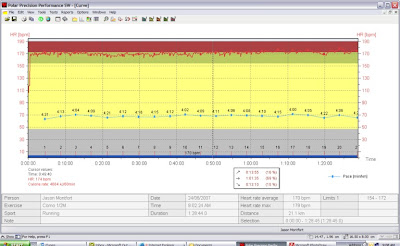In response to
Hamburglar's question regarding my impression on whether a HRM/GPS slows you down or makes you race smarter I present the statistics from last Sunday's Como Landing Half Marathon. During this run I completely ignored my heart rate and split times. To give a frame of reference I'll compare this race to the half marathon at Williamstown from 4 weeks ago where I took a lot more notice of my heart rate and splits.
During my warm up I noticed my heart rate was up high, which is often the case over the first 10 or so minutes, but it did not settle down much afterward. Maybe it was because it was cold, or maybe because of my recent sporadic training. Whatever the case I decided there was a chance it wasn't going to be a reliable indicator. Because the course was undulating, kilometre race splits were going to vary significantly depending on whether that k was mainly uphill or downhill. I don't own or use a GPS unit, and currently don't have much of interest in getting one.
Now onto heart rate. My maximal heart rate is 191bpm. This is accurate. I spent four years as a lab rat involved in countless exercise studies that repeatedly measured everything from VO2max, anaerobic threshold, maximal power output, sustainable power output, aerobic enzymes, muscle buffering capacity, muscle fibre type distribution and maximal heart rate. I have compared these results to field testing and am confident this is my actual HRmax. It is not derived from an inaccurate formula such as 220-age.
During the Como race I averaged a HR of 170bpm, 89% of HRmax. (Williamstown, HR 162, 85%). My peak HR was 179bpm, 94% HRmax (Williamstown, HR 171, 90%).
Based on these values I was working 4% harder at Como. Both races showed very little variation in HR, no more than 5bpm below average, and 9bpm above average. Leaving a total variation of 14bpm. That is pretty tight.
At Williamstown I averaged a pace of 4:16/km, running at about 4:12 with the tail wind and 4:20 into the headwind. I stuck to these splits deliberately, making sure my HR about 85% and this did give me a good even race. Yes the last few kilometres were hard, but only as expected.
At Como Landing I averaged 4:13/km, but definitely ran a negative split. For comparison I'll break up the race into its three laps of 7km.
- Lap 1 30:00 HRav 169, HRmax 176
- Lap 2 29:30 HRav 170, HRmax 174
- Lap 3 29:10 HRav 173, HRmax 179

It was at between 12 and 13km that I decided to increase the pace slightly and this is reflected in a small but noticeable increase in HR to above 170bpm. This is the point I felt like I was close to my limit. This is what many people would term the anaerobic threshold, the point at which lactate production increases above lactate removal in the exercising muscles. The point at which the burn starts to hurt.
After sitting back and comparing both races I believe they were both run well and appropriate to the race conditions. At Como Landing I think if I had of checked my HR I would have slowed down somewhat, and lost time. Running by kilometres splits at this race would have been ridiculous due to the terrain, after all my pace varied between 4:21 and 4:00/km. In this situation running on feel worked in my favour. Williamstown I found that the strong winds distorted my feel for the race, and checking my kilometre splits against heart rate made sure I was able to put in a consistent effort over the 21km. In this case I needed the HRM.
I don't favour one method over the other. I enjoy running on feel, I often have my faster races doing this, but I also have a history of blowing up early using this method. I think you can only use HR and splits if you have a consistent training base behind you from which you have developed a strong sense of feel versus heart rate. I also have to add that while I may not be able to tell exactly what pace I am doing compared to the other day, I seem to have a very good ability to compare my pace and effort inside a single run. I can run for 2-3 hours on an out and back course and finish with a deliberate 1-2 minute negative split without checking my watch.
Learn your average numbers during training, and sometimes be guided by them during a race. But remember no one won a race or smashed their personal best by limiting how fast they ran because their heart rate was high if their legs felt good.
"Doubt is not a pleasant condition, but certainty is absurd." - Voltaire



As always, a thorough analysis. Just what I was looking for.
ReplyDeleteIt would be interesting to do the same analysis with marathons, because they just FEEL so easy in the first 10k's and so easy to go too quickly.
Cheers!
I never wear a HRM to race, I figure it is all or nothing when racing and I am trying to learn to race on feel.
ReplyDelete